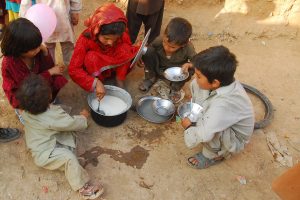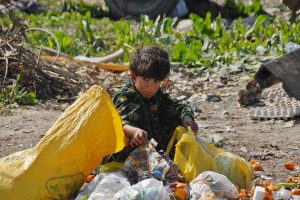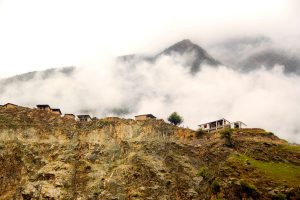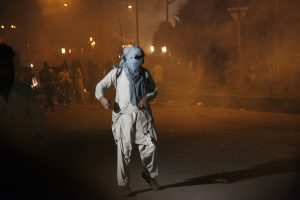Saadia Sehar Haidri has broken down barriers but is still up against a male-dominated wall
Saadia Sehar Haidri’s story is one triumph over agony, a journey borne out of the emotional depths of losing her husband in a terrorist attack that reached the professional high point of becoming Pakistan’s first-ever female photojournalist. But despite Saadia’s many achievements, hers remains a rocky road given the prevailing stereotypes in a male-dominated society.
Born in Lahore in February 1970, Saadia was one of eight children, two boys and six girls. Her father was a famous lawyer who would quit the profession after being threatened for defending an accused murderer. After moving with her family to Islamabad, Saadia began her studies, eventually obtaining a Master’s degree in Mathematics from Punjab University and another in Mass Communications from Allama Iqbal Open University.
But it was while teaching at a private academy in the Pakistani capital that her life’s course was set. It was then that she met Aziz Ullah Haidri, who by night tutored young Afghan students in English. Aziz was born in Kabul but fled with his family to Peshawar during the Soviet invasion. After completing his tertiary studies, he too moved to Islamabad.

(Courtesy: Saadia Sehar)
“He was smart and handsome, but I had no intention of marrying him,” Saadia explained in an exclusive interview with The Media Line. “We became good friends and fell in love but we faced problems from our respective families. They were against the relationship because we were from different countries and had different cultures. My parents did not think Aziz would be a good husband because he is Afghan. Nevertheless,” she asserted while visibly holding back tears, “we were married after a four-year lover affair on January 28, 1996.”
Within months Saadia gave birth to a baby girl and three years later to a son. She quit her teaching job to focus on raising her children.
For his part, Aziz had been working for half a decade as a correspondent and photographer for the Reuters news agency. In 2001, following the launch of U.S. military operations in Afghanistan, he was sent to London for three weeks for conflict-zone training. Aziz had barely returned home before he was again dispatched abroad—to put his preparation into practice.
Aziz’s circle of life tragically came full circle near his birthplace. On the morning of November 19, 2001, his convoy was ambushed by the Taliban near the town of Sarobi, a district in Kabul Province. Aziz and other foreign journalists were dragged from their vehicles and taken hostage in the surrounding mountains.
“One of the drivers who survived,” Saadia recalled, “tracked me down and told me that Aziz had begged in his native language for mercy for all of them. He told the [captors] that he is an Afghan Muslim and that the foreigners were his guests. The Taliban commander offered Aziz refuge but he refused to go alone.
“I didn’t talk about it to my children for eight years,” she continued, again wiping her eyes dry. “Eventually, they came to know that their father was martyred.”
While mourning the loss of her husband, Saadia was offered a job by Reuters which she accepted. Being in the offices reminded her of the times she had visited Aziz at work. “I assumed this profession for my beloved husband as I wanted to continue his mission in journalism,” she explained to The Media Line. “I wanted to carry on his legacy.”

(Courtesy: Saadia Sehar)
To this end, Saadia demanded that she be given Aziz’s old position but was refused by the bureau chief, who did not believe a Pakistani woman could be a successful photojournalist. “We live in a male-dominated society,” she stressed, “and when I joined this field it was mostly men that discouraged me. ‘You are a woman, you cannot do this,’ they would say.”
Saadia quit working for Reuters and found employment at the Visual News Network, where she worked for six years. There, she benefited from the experience gained during her childhood. “I was good with taking pictures even before,” she explained, “a skill inherited from my grandfather who himself was a famous Pakistani photographer. In 1986, my father gifted me an old Yashica camera, which I used throughout my years in university.”
Against all odds, Saadia’s ability quickly translated into professional success. Over her career she has worked as a staff writer and photojournalist for the Associated Press of Pakistan and also as a current affairs host and producer for Vectone TV. She has contributed to numerous other organizations including Nikhar (a local Urdu weekly), the INP news agency, Geo News and, presently, the Chinese official Xinhua News Agency.
But it has not been an easy ride.
By virtue of being a woman Saadia was turned away by countless media outlets, endured verbal abuse from her colleagues and had editors treat her “as a piece of meat.” Overall, male photojournalists in Pakistan tend to be less-trained and thus have often been jealous of Saadia’s abilities, which include an expertise in video mixing and editing and other technical skills. While her mother tongue is Urdu, Saadia can speak and write fluently in both English and Persian.

(Courtesy: Saadia Sehar)
“In this professional environment, it is quite difficult for women to stand shoulder-to-shoulder with men,” Saadia affirmed. “Many cases are reported in which female journalists were exploited or harassed by their supervisors or other workers. Due to this alarming situation, women reporters have chosen to quit.
“Islam has given rights to both genders,” she added, “but unfortunately women are being crushed under the brutal and cruel administration of men.”
As part of her job Saadia was also required to travel throughout Pakistan, forcing her to leave her children with their grandmother for lengthy periods. “My children are good, hardworking and help me all the time despite my frequent absences from their lives,” she told The Media Line. “They know very well that their mother and father have sacrificed much for them.”
As a result, the children have become protective of Saadia, ensuring that she does not write anything too controversial related to human rights violations or any other sensitive issues that could jeopardize her safety.
The job itself is sufficiently dangerous. In September 2007, for example, while covering a demonstration against former military ruler Pervez Musharraf, Saadia was beaten and arrested by police. Two months later, while protesting against a ban on Geo News, she was again detained.

(Courtesy: Saadia Sehar)
In another instance, Saadia wrote an open letter to the Taliban after Wall Street Journal reporter Daniel Pearl was kidnapped. In it she appealed for the journalist’s release, citing her own experience as the victim of similar brutality. After the letter gained widespread traction, Sadia’s was repeatedly threatened, first through phone calls to her office and then directly to her mobile.
For all her struggles, Saadia has received numerous accolades. She has been selected to attend many international programs and seminars on photojournalism and had the opportunity to visit Washington under the U.S.-Pakistan cultural exchange program. In 2011, the not-for-profit Rural Media Network Pakistan recognized her courage by awarding her a press freedom prize.
Some of those whose who have worked with Saadia have come to appreciate her professionalism. One such example is Namood Muslim, a senior journalist at Pakistan Television News in Islamabad who has known Saadia for twelve years. “She was a simple house wife but after the assassination of her husband the way she adopted his mission is really admirable,” he told The Media Line. “At first it felt very strange that a woman was doing all of these things with the camera, but now Saadia is role model for me. She has the utmost courage, commitment and dedication and did something that nobody could have even imagined.”
BK Bangash, a prominent male photojournalist at the Associated Press of Pakistan, also described Saadia to The Media Line as a pioneer. “Saadia has so much passion for her work and has created a new chapter in our history. She is a source of inspiration for all young females,” he affirmed.
Saadia has indeed broken down barriers, all in an effort to promote Aziz’s legacy, which is increasingly strengthened through the accomplishments of their children. “Our daughter Aleena is studying medicine and will be a doctor in two years. Muhammad Ammad, our son, is also in college but his goal is to become a pilot.
“Of course I got a lot of criticism from male colleagues and still I am facing it,” she concluded, “but I accept all the challenges for my beloved husband and for my kids.”